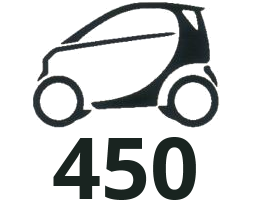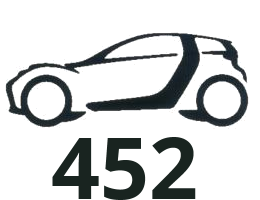Mod Description
Cruise control is handy in many situations, if you have a 600cc or a diesel in Canada this is the best way to add this function. It can be added to all smarts if you cannot obtain a TAN code.Mod Details
PremiumNo Difficulty



 Mod ID390
CreditSteven M
For
Mod ID390
CreditSteven M
For
 Linkhttps://www.evilution.co.uk/mod/mdc-450-cruise-control.htm Copy to Clipboard
Linkhttps://www.evilution.co.uk/mod/mdc-450-cruise-control.htm Copy to ClipboardYou can buy this from the MisterDotCom website.
Fitting The MDC Cruise Control Board
Kit Contents
- Cruise control circuit board with accelerator cable attached
- Genuine Smart cruise control/wiper arm switch
- Switch cable
- Main power wiring harness and cable
- LED cable (LED attached)
- Black plastic LED bezel
- Foam square

Tools Required
- 10mm Socket Wrench. Small 1/4′ drive with a 3-4′ extension seems to work best.
- T-10 Torx Bit screwdriver
- Zip ties to secure the cables and scissors to tidy them up when done
- An electric drill with a 5/16′ general-purpose drill bit
- A small nail or something similar slender and rigid (not necessarily sharp)
- Three small pieces of masking tape and a pen
*NOTE* It is REQUIRED that you follow instructions provided in your car’s manual and disconnect the battery before installing, removing, or moving the cruise control circuit board or connecting/disconnecting any of its cables. The warranty does not cover electrical or physical damage to the unit. Following these instructions will avoid this.
Preparation and precautions
Before starting, make sure you have your car’s stereo security code since you will be disconnecting the battery. The dealer where you bought the car should be able to provide this for you if you don’t have it.
Lay out all parts that come with the cruise control and identify all the components. The orange connectors on the grey cables as well as the circuit board are especially susceptible to damage so take extra care when handling.
Dismantle the speedometer housing
Using the T-10 screwdriver, loosen and remove the four screws on the underside of the steering column cover. This frees the upper part of the cover and the speedometer housing. There are many wires connected to the back of the housing. Carefully turn the housing so you can see the wiring on the reverse, but be sure not so put too much strain on any of the wiring when you do so.
The Accelerator Pedal
On any other car, this would be a tough job for sure. In the smart, its simply loosening the four nuts and undoing the wire clip and you’re done. The nuts are loosened using a 10mm socket or any other suitable tool. It can be tricky getting at them because of the tight surroundings with the one toward the front/right of the car being the hardest. A use of a flexidrive can aid removal.
Once the nuts are completely loosened (note that they do not come off entirely), lift the entire pedal assembly up off the bolts and turn it so you can get your hands in to the back where the cable goes in. You may need to gain more slack from the cable by adjusting the carpet to allow more give.
To undo the cable, there’s a tab you have to press and then it pulls out. A somewhat firm pull is needed to get it out because it is sealed with weather-stripping, but you should not have to force it. Avoid pulling by the wires! Try to grip the plastic connector itself instead.

With the pedal separated from the cable, set it aside for now.
Carefully pull the driver side carpet down from the center pillar (there is a single metal clip holding it in place near the center column – see the red circled area in the photo below) and feed the cable through the hole in the carpet. Some cars have that cable taped down beneath the carpet directly behind the opening, which you’ll have to remove. Remove the plastic clip (see yellow circled area in photo below) by inserting a nail in the center of the clip to push out the centre pin. Put your fingers in behind it to catch the pin so you don’ t lose it when it drops. Now feed the cable through the center column to the passenger side foot well (which should be easily accessible at this point as you removed the passenger footrest to disconnect the battery, right?) and leave loose for now.

Making The Connections Part 1
Included with your cruise control, you will find a cable harness with male and female ends as shown here, as well as one long grey wire with an orange connector at the end (this is part #4 in the contents list).

Look for a block of cables going into the back of your speedometer that has a connector similar to the male end of the above mentioned cables. *Note* these connectors are special and are not simple plug in and pull out types. There is a small arcing mechanism that locks the plug into place that you must swing approximately 90 degrees before it is loosened/tightened.
Do not force anything! Be sure everything is lined up squarely and in all the way and it won’t take much force. It is a good idea to first examine the male plug shown above closely before moving on. Take note of the small plastic tab that needs to be pressed before you can swing the locking mechanism open. Conversely, when fully closed that tab should click into place and prevent the mechanism from moving open.
With the above in mind, go ahead and unplug the original male connector from the back of the speedometer and plug it into the female connector shown in the cable harness pictured above. Then you will take the male connector of the harness
shown above and plug it into the place where the original one was in the back of the speedo, being sure to lock it in place as described above.
Fit the cruise control stalk as seen here.
Running The Cables
You’ll be running the three grey wires together… these are:
1) the wire attached to the main harness,
2) the one you attached to the wiper control arm, and
3) the LED cable (part #5), which is not yet connected to anything
and will be left loose in the speedo area for now.
Mark the three cables with some masking tape and a pen so you can identify the three cables later since they all have identical connectors. Mark them “LED”, “POWER”, and “SWITCH” near the orange connectors.
Pull down the felt cover that is above the driver footwell (left hand drive only). If your arms are long enough, you can reach up behind there while you are looking down along the right side of the steering column. See your hand and feed all three cables, orange connectors first, along the right side of the steering column, back and down into driver footwell area. From there, send the three cables through the centre column over to the passenger side footwell.
Back up in the speedo area, use a small nylon zip strap to secure the three wires (semi-loosely) to the existing cable that runs near the right side of the steering column to keep them from touching the steering column.
Making the Connection Part 2
Take the cruise control unit (part #1) to the passenger side footwell, where you should have your three grey cables with the orange connectors (nicely labelled) as well as our accelerator pedal all hanging loose. Plug the accelerator cable into the end of the cruise control with the 6 pins.
*CAUTION* Be absolutely sure you are plugging in the cable that is connected to the car, not the identical looking cable that is soldered to the other side of the cruise control! This would create a loop and would fry the circuit board the moment it gets power.
As well, it is very important that you plug it in the correct way, which is to locate the tiny ‘1’ imprinted on the plastic of the accelerator cable connector and match that up so that it is closest to the tiny ‘1’ printed on the circuit board. When installed correctly, colours of the wires will line up (ie. the purple wire of the accelerator cable is in line with the purple wire at the other end of the cruise control) and the clip of the accelerator cable connector will be facing ‘up’ (ie. the same side the orange connectors are on the circuit board).
Use a small nylon zip tie as illustrated to secure the cable in place.

Connect the three grey cables with the orange connectors to the three matching orange connectors on the circuit board. The circuit board’s connectors are each marked with ‘Power’, ‘LED’, and ‘Switch’ respectively (you labelled your cables, right!). It is very important you insert the connectors in the correct way – there is a small ‘key’ or tab on one side of each connector of the cables and a respective indent on the circuit board for it to mate with (albeit loosely).
When inserted correctly, the cables should tend to run toward the end of the circuit board that has the 6 pins that you plugged the accelerator pedal into. Use small nylon zip tie to secure the grey wires as shown below.

Now, feed the cable that looks like the original accelerator cable back through to the driver side foot well and through the hole in the carpet and connect it to the back of your accelerator pedal pressing firmly so as to get a good connection (it should click)
Preliminary Test
Before moving on, you should check to confirm this thing’s going to work! You should begin by double-checking all your connections. Nothing is really put away at this point, so be sure there’s nothing touching your cruise control in such a way that could possibly cause a short when we reconnect the power. When satisfied, go ahead and reconnect your battery.
Press the unlock button on your key fob to clear the immobilizer if applicable. Turn your key to the ‘1’ position to get power to your speedo and look at the instrument cluster. If you see horizontal bars in your gear indicator display or something else unusual, turn the power off and re-check all your connections.
Look at the LED at the end of the LED cable. At this stage it should be flashing rapidly (at least for 10 seconds after you turned the power on). If it is not, then re-check your connections. Feeling brave? Turn your car’s engine on.
If your engine races immediately shut it off! Then re-check your connections. If it appears normal, press the accelerator pedal with your hand and confirm that it is responding as expected. While the car is running, look at your instrument panel again. You should not have a check engine light come on if everything is properly connected and running fine (see note at bottom if you do).
When satisfied, turn off the car and disconnect the battery again before continuing.
Installing The LED
First you must choose where you want the LED. For complete installation, you will have to drill a small hole somewhere, and it is largely up to you to decide where is best. People have found very clever and varied places to put the LED… the following is my suggestion.
locate a spot about 5 to 7 mm in front of the clear plastic of your speedo, and approximately 5 to 10 mm from the right side. Carefully drill the hole up from underneath being certain your drill bit doesn’t hit anything else after its come through. Feed the led cable through the hole. Put the black bezel (part #6) over the LED, and push the bezel and cable back into the hole until it is secure.
Wrapping Up
Now that everything is connected, it’s time to finish up and get everything tucked away. First, take the foam square (part #7) and wrap it around the circuit board and secure somewhat loosely with two or three nylon zip ties. It is important you don’t crush the orange connectors in this step! Carefully tuck it away in the cavity of your center console, similar to that shown.

Re-install your accelerator pedal by lining up the plastic nuts with the bolts protruding from the floor and tightening with your 10mm socket – do not over tighten. Being sure not to pinch any cables, re-attach your speedo housing using the
four T10 Torx screws you removed earlier. Reconnect your battery, replace your passenger foot rest and all carpeting and re-insert the centre console pop-clip you removed earlier (just put in the clip then re-insert the little pin).
Complete the installation by prying the decorative end cap from the original stalk, with the aid of a sharp knife, and then snapping it onto the new stalk.
Read the User Manual, program your cruise control as required and go for a test drive!
Fault Finding
If you did have a bad connection and the check engine light came on because of it, it may not go out immediately once you’ve corrected the problem. If everything is connected properly and running fine, the light should correct itself after driving the car a few times (sometimes minutes, sometimes a couple days with multiple engine stops/starts).
If it persists longer, and you are CERTAIN the cruise is operating properly, you may need to use an X-Gauge or ScanGauge II or take your car to the dealership to have it cleared.
There have been cases of defective cruises over the years. While symptoms such as immediate and rapid engine racing, horizontal bars in the instrument panel, dead accelerator pedal, and non functioning LED are usually caused by a poor connection, they have also been caused by a defective module.
If You Bought From SmartieParts
If you are convinced you have a dud, contact SmartieParts for a return authorization and we will test it. If it is defective, we will cover all shipping costs and get you a replacement (but if its a bad connection, it simply goes back to you on your dime). SmartieParts is the only authorized distributor of cruise controls in North America and the only ones authorized to do warranty returns. The cruise control warranty does not cover electrical or physical damage as stated earlier, but defects are handled as promptly and hassle free as possible if purchased through SmartieParts or its authorized retailer (check with us before buying elsewhere to be sure it is authorised).
If You Bought Elsewhere
Contact your supplier, wait and hope.



